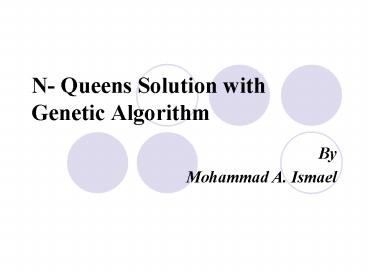N Queens Solution with Genetic Algorithm - PowerPoint PPT Presentation
1 / 17
Title:
N Queens Solution with Genetic Algorithm
Description:
A queen can move horizontally, vertically, or diagonally. The problem can be solved with genetic algorithm for a n queens problem. ( n is between 8 and 30) ... – PowerPoint PPT presentation
Number of Views:1310
Avg rating:5.0/5.0
Title: N Queens Solution with Genetic Algorithm
1
N- Queens Solution with Genetic Algorithm
- By
- Mohammad A. Ismael
2
N-Queens problem Definition
- Place N queens on an NN board so that no queen
is attacking another queen. - A queen can move horizontally, vertically, or
diagonally. - The problem can be solved with genetic algorithm
for a n queens problem. (n is between 8 and 30)
Here N8
3
8-Queens problem
- Simple solutions may lead to very high search
costs - 64 fields, 8 queens gt 648 possible sequences
- Genetic algorithm solution trim the search space.
4
Problem formulation
- Initial State n queens placed randomly on the
board, one per column. - Successor function moving one queen to a new
location. - Cost The number of queens that hit each others.
5
Genetic consists of
- Genes
- Chromosomes
- Populations
6
In n-queens
- A gene is a number between 0 to n-1.
- Is a position of any queen in the board
- A chromosome is an array of these genes. It
could be the solution. - Population is a generated set of chromosomes.
7
Chromosomes and genes
A chromosome (array of genes. It could be an
answer)
- 3,6,8,5,1,4,0,7,9,2
- 7,6,9,5,1,4,0,3,8,2
- 9,6,1,5,8,4,0,7,3,2
- 6,3,8,5,2,4,0,7,9,1
- 3,6,8,5,1,4,0,7,9,2
- .
- .
- .
Gene
Population
Here N10
8
Create a random initial population
- An initial population is created from a random
selection of chromosomes. - The number of generations needed depends on the
random initial population.
9
Finding the cost
- To find the assigned cost for each chromosome a
cost function is defined. - The result of the cost function is called cost
value. - This value is used for chromosomes ranking
- The best (minimum value) is placed on top and the
worst (maximum) is placed in the bottom.
10
Producing next generation
- Those chromosomes with a higher fitness (lesser
cost) value are used to produce the next
generation. - The offspring (or Child) is a product of the two
parents, whose composition consists of a
combination of genes from them (this process is
known as "crossing over"). - If the new generation (Child) contains a
chromosome that produces an output that is close
enough or equal to the desired answer then the
problem has been solved. - If this is not the case, then the new generation
will go through the same process as their parents
did. This will continue until a solution is
reached.
11
Steps to solving the problem with GA
- Clear the board.
- Generate the initial population.
- This generation is a purely random generation.
- Fill the chess board with a chromosome.
- For example,
- Let Chromosome Matrix 3,6,8,5,1,4,0,
- 7,9,2,
- Here Chess Board Length 10 (n10).
12
Steps to solving the problem with GA
- Determines the cost value for each chromosome
matrix. - For example,
- For chromosome 2,6,9,3,5,
- 0,4,1,7,8 , the cost value will be 2
- Because of there are two queens
- that hit each other
13
Steps to solving the problem with GA
- Sort the new generation according to their cost
value. - The best (minimum) is placed on top and the
worst (maximum) is placed in the bottom. - Generate the cross over matrix. This matrix
contains 0s and 1s.
14
Steps to solving the problem with GA
- Generate children from parents using cross over
matrix. - Genes are drawn from P0 and P1.
- A gene is drawn from one parent and it is
appended to the offspring (child) chromosome. - The corresponding gene is deleted in the other
parent - This step is repeated until both parent
chromosomes are empty and the offspring contains
all genes involved.
15
Steps to solving the problem with GA
- Apply mutation to the current generation.
- First of all, a random chromosome is selected
but the first (best) one in the list. - Then, two random genes of this chromosome are
selected and replaced with each other. - Increasing the number of mutations increases the
algorithms freedom to search outside the current
region of chromosome space.
16
Example of such software
17
- Questions?































